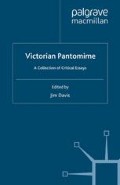Abstract
John Ruskin enthusiastically attended the theatre throughout his life, particularly enjoying pantomimes. As a child, Ruskin found every pantomime ‘a matter of intense rapture’;1 as an old man, he still enjoyed it as one of his few untarnished delights.2 But in addition to his own pleasure in theatrical entertainment, because pantomime reaches all classes, it is for Ruskin a perfect popular cultural reference to illustrate his points in urging a more just society. His books for working class readers Fors Clavigera and Time and Tide both depend on analyses of fanciful pantomimes to make their arguments. In these and other works, Ruskin wants most for theatre to provide a link to the world outside, not, as one might think, to represent that world more accurately or realistically and also not simply to function as a didactic tool telling moral stories, but rather to make manifest in performance the possibility of other ways to act. In other words, as I have written elsewhere, for Ruskin the enactment of a fictional existence, identity, or idea on stage momentarily realizes it.3
Access this chapter
Tax calculation will be finalised at checkout
Purchases are for personal use only
Preview
Unable to display preview. Download preview PDF.
Notes
The Works of John Ruskin. ed. E. T. Cook and Alexander Wedderburn (London: George Allen. New York: Longmans Green and Co., 1903–12), 35: 175.
See Sharon Weltman, Performing the Victorian: John Ruskin and Identity in Theater, Science, and Education (Columbus: Ohio State University Press, 2007).
See Van Akin Burd, Christmas Story:John Ruskin’s Venetian Letters of 1876– 1877 (University of Delaware Press, 1991), p. 88, for a brief discussion of this moment.
See Davis, ‘The Employment of Children in the Victorian Theatre,’ New Theatre Quarterly 2.6 (1986), pp. 116–35.
Ibid., vol. 34, pp. 545–6; Joan Evans and John Howard Whitehouse, eds., The Diaries of John Ruskin, 3 vols. (Oxford: Clarendon Press, 1959), Vol. 3, p. 999;
Tim Hilton, John Ruskin: The Later Years (New Haven and London: Yale University Press, 2000), p. 428.
E. L. Blanchard, Jack in the Box; or, Harlequin Little Tom Tucker and the Three Wise Men of Gotham (London: Tuck and Co., 1873), p. 18.
Editor information
Editors and Affiliations
Copyright information
© 2010 Sharon Aronofsky Weltman
About this chapter
Cite this chapter
Weltman, S.A. (2010). ‘Arcadias of Pantomime’: Ruskin, Pantomime, and The Illustrated London News. In: Davis, J. (eds) Victorian Pantomime. Palgrave Macmillan, London. https://doi.org/10.1057/9780230291782_3
Download citation
DOI: https://doi.org/10.1057/9780230291782_3
Publisher Name: Palgrave Macmillan, London
Print ISBN: 978-1-349-30711-1
Online ISBN: 978-0-230-29178-2
eBook Packages: Palgrave Theatre & Performance CollectionLiterature, Cultural and Media Studies (R0)

